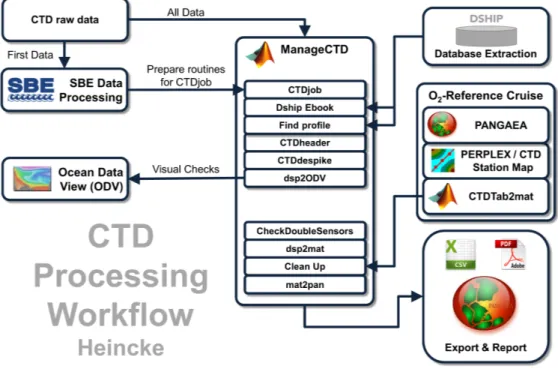CTD Data RV Heincke HE547
Data Processing Report
Contents
1 Introduction 1
2 Workflow 1
3 Cruise details 3
4 Sensor Layout 3
5 Processing 3
6 Results 5
Contact:
Gerd Rohardt
Alfred-Wegener-Institute
Am Handelshafen 12, D-27570 Bremerhaven, GERMANY Mail: info@awi.de
Processing Agency:
FIELAX GmbH
1 Introduction
This report describes the processing of CTD raw data acquired by Seabird SBE 911plus CTD on board RV Heincke during expedition HE547.
2 Workflow
The different steps of processing and validation are visualized in Figure 1. The CTD raw data are delivered from Andreas Wisotzki (AWI). The station book of the RV Heincke cruise is extracted from the DAVIS SHIP data base (https://dship.awi.de). The first CTD station and cast is processed man- ually in SBE Data Processing to configure the *.psa Seabird routines Data Conversion, Wild Edit, Bottle Summary,Split,Translate,Cell Thermal Mass,Loop EditandBin Average. The Seabird rou- tines are then run in a batch jobCTDjobin ManageCTD to process the complete CTD data set. The downcast of each CTD station/cast is used for further processing. InCTDjobthe start record and the lowest altimeter point of the downcast is selected. With theUtilities→Dship Ebook function of ManageCTD the DAVIS SHIP station book extraction is used for getting the header information of all CTD stations/casts of the cruise. ManageCTDUtilities→Find Profilefunction compares station times of the header with the entries in the station book to find out the correct naming of the sta- tions and casts. InCTDheader in ManageCTD the header information of each CTD station/cast is displayed, controlled and corrected if necessary. CTDdespike in ManageCTD is used for a visual check of the data and to erase/interpolate spikes in the data if necessary. Additionally, a sensor pair (Temp1/Sal1 or Temp2/Sal2) is chosen for each station/cast of the RV Heincke cruise in CTDde- spike.
ManageCTD Utilities→CheckDoubleSensors controls the quality of temperature and conductivity sensors. For this purpose outliers of too high sensor pair differences could be removed. The data is then converted to spreadsheet format with dsp2odv for visualization of the data in Ocean Data View (ODV). The processed CTD data are written to text files and imported to PANGAEA (http://www.PANGAEA.de) for publication.
Figure 1: CTD data Processing Workflow
3 Cruise details
Vessel name RV Heincke Cruise name HE547
Cruise start 26.02.2020 Bremerhaven Cruise end 28.02.2020 Bremerhaven Cruise duration 3 days
No. of CTD casts 28
4 Sensor Layout
This chapter describes the CTD sensors mounted during this cruise. No oxygen sensors were de- ployed during HE547.
SBE 911plus CTD (SN: 1015), SBE Instrument Configuration Version 7.23.0.1.
ID Sensor Name Serial No. Calibration Date
55 TemperatureSensor 5354 13-Dec-19
3 ConductivitySensor 2470 17-Dec-19
45 PressureSensor 1015 26-Jan-17
55 TemperatureSensor 5375 13-Dec-19
3 ConductivitySensor 3573 17-Dec-19
0 AltimeterSensor 46466 23-Mar-09
71 WET_LabsCStar 1348DR 28-Jan-2016
20 FluoroWetlabECO_AFL_FL_Sensor 1365 15-Jan-2016
5 Processing
Details of processing procedures and processing parameters are described inCTD Processing Log- book of RV Heincke(hdl: 10013/epic.47427).
Density Inversions and Manual Validation
Obvious outliers were removed manually. For the visual check density inversions > 0.005kg/m3and
> 0.01kg/m3 were flagged differently for display but not removed automatically. Decisions whether the flagged values were manually removed or not are based on the description inCTD Processing Logbook of RV Heincke(hdl:10013/epic.47427).
Sensor Differences
6 Results
A complete processing overview for each sensor at each station is summarized in the table in the Appendix (Figure 3).
Double Sensor Check
In Figure 2, the absolute residuals between the sensorpairs are shown for the measured parame- tersTemperatureandConductivity, the derived parameterSalinity. Measurements in shallow water depths < 15 m (blue crosses) and gradients between two datapoints exceeding a defined threshold (red crosses) were omitted for accuracy calculation.
Parameter Accuracy Measurements
removed
Remaining measurements given by manufacturer Surface 0-15m within accuracy
+ gradient filter specifications
Temperature ±0.001◦C 62.58% 79.86%
Conductivity ±0.003mS/cm 67.64% 36.30%
Salinity ±0.0015P SU 68.08% 5.21%
Comments
• 27 CTD "max depth/on ground" entries in DShip station book
• 1 Expendable Bathythermograph entry in DShip station book with CTD as Action entry
• 28 CTD raw data sets delivered
• All CTD casts had file names different from DShip station book names.
• No oxygen sensors were attached to the CTD during HE547.
• 28 CTD casts processed and uploaded
• of these 28 processed CTD casts:
– 36 data points interpolated – 2 data points erased
Result files
Text File (HE547_phys_oce.tab):
The format is a plain text (tab-delimited values) file.
Column separator Tabulator "\t"
Column 1 Event label
Column 2 Date/Time of event
Column 3 Latitude of event
Column 4 Longitude of event
Column 5 Elevation of event
Column 6 DEPTH, water
Column 7 Pressure, water
Column 8 Temperature, water
Column 9 Conductivity
Column 10 Salinity
Column 11 Temperature, water, potential Column 12 Density, sigma-theta (0)
Column 13 Oxygen
Column 14 Oxygen, saturation
Column 15 Attenuation, optical beam transmission
Column 16 Fluorometer
Column 17 Number of observations
Processing Report (CTD-HE547-report.pdf):
This PDF document.
